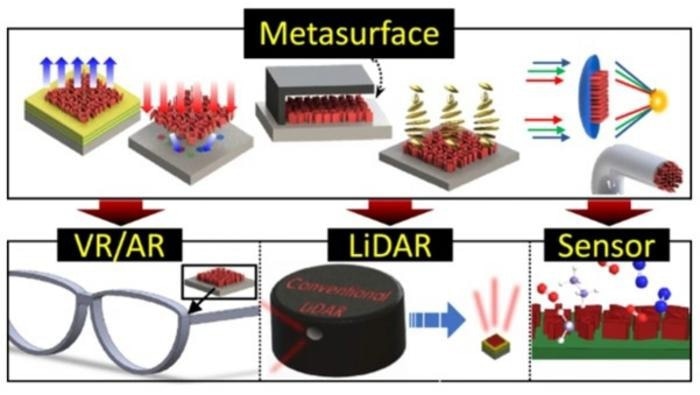Metasurfaces are manipulable artificial materials that can enable lenses to be lowered to one 10,000th the size of traditional lenses. As a result, metasurfaces have received interest as optical components for the next generation of virtual and augmented reality, as well as LiDAR.

Introduction of and applications for a near-future micro-optical platform using metasurfaces. Image Credit: POSTECH
Recent research published in Light: Science and Applications summarizes the research trends in a near-future micro-optical platform based on metasurfaces. The study also puts forth future research directions and methods for commercialization.
The study was led by Professor Junsuk Rho from the Department of Mechanical Engineering and the Department of Chemical Engineering along with PhD Candidates Younghwan Yang, Junhwa Seong, Minseok Choi, and Junkyeong Park, (co-lead authors) from the Department of Mechanical Engineering at Pohang University of Science and Technology (POSTECH), and Dr Gyoseon Jeon, Dr Kyong-il Lee, and Dr Dong Hyun Yoon from the Research Institute of Industrial Science and Technology (RIST).
Traditionally, metasurface research has focused on the complete manipulation of light’s characteristics, yielding a wide range of optical devices like metalenses, metaholograms, and beam diffraction devices. Nonetheless, recent research has shifted its focus to integrating metasurfaces with other optical components.
In their paper, the research group suggests research of and applications for integrated metasurfaces. These integrated metasurfaces are optical components that can be used with other standard optical components like light-emitting diodes (LEDs) and liquid crystal displays (LCD). The research team proposed that future research in the area should concentrate on integrating metasurfaces into commonly used devices, making them relevant in everyday life.
Moreover, the research team emphasizes the significance of industry-academia collaboration, emphasizing the effect that metasurface research can have on the future optical device industry and national competitiveness. They emphasized the importance of national-level support and cooperation in developing innovative optical platforms.
Integrated metasurfaces complement existing electronic technologies and represent another innovative solution for a variety of applications.” He added, “I hope there will be sustained efforts, research, and national support that will lead to even more innovative outcomes.
Junsuk Rho, Professor, Department of Mechanical Engineering, Pohang University of Science and Technology
The study was sponsored by a program of POSCO’s Industry-Academic Integrated Research Center, the STEAM Research Program of the National Research Foundation of Korea funded by the Ministry of Science and ICT, the Doctoral Student Grant Program of the Ministry of Education, Samsung Science and Technology Center, and Chung Mong-Koo Foundation.
Source: https://postech.ac.kr/eng